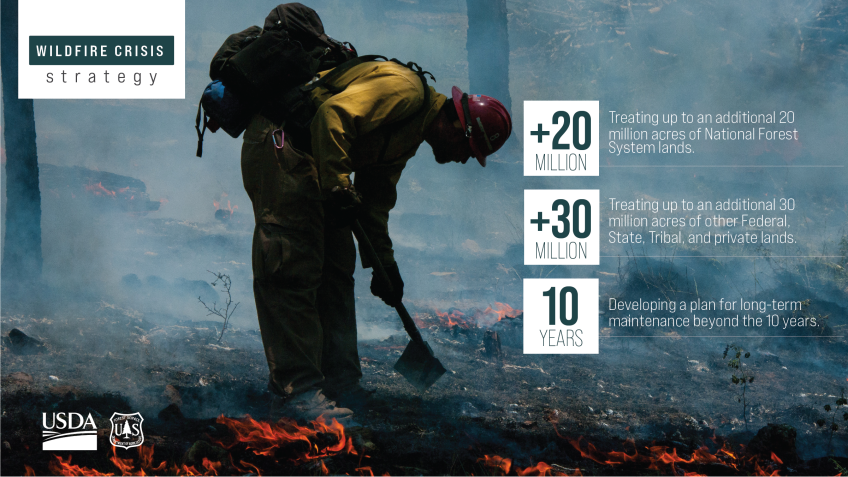Confronting the wildfire crisis: A new strategy for protecting communities and improving resilience in America’s forests
Please join USDA Secretary Vilsack and me virtually today at about 1:40 p.m. Eastern as we announce a new national strategy to confront the wildfire crisis facing the nation, which has threatened and destroyed lives, homes, land and communities, especially in the West. This historical announcement marks a paradigm shift in the scale of our fuels and forest health treatments to match the actual scale of wildfire risk.
For some time now, our limited resources have constrained us. Despite that challenge, your “Can Do” spirit allowed us to go above and beyond what should have been possible. Our collective efforts have yielded astonishing results and earned the trust of communities and lawmakers.
That said, we all know there is still so much work to do. Climate change is driving hotter, longer and more severe wildfire seasons, and wildfire behavior is becoming less predictable. Because of your efforts and the relationships you have created and maintained, our approach to these challenges is about to change. The Bipartisan Infrastructure Law provides nearly $3 billion to reduce hazardous fuels and restore America’s forests and grasslands, along with investments in fire-adapted communities and post fire reforestation.
This investment and the public trust to deliver results require us all to change the way we think about our work. We must think innovatively about how to use these resources to confront the wildfire crisis in the West. This is the core of our mission to sustain the health and diversity of the nation’s forests. This is what we’ve been working toward for so long, together.
Take a moment to let this sink in. We can change the trajectory of catastrophic wildfires in the West. We will capitalize on our science, partner relationships and land management expertise to confront the massive scale of the problem. This is our moment to innovate. Let’s not be afraid of what is unknown, rather focus on what can be with our collective effort. All our priorities matter and we will work together to achieve them.
As the challenges we face in land management evolve, so must our approach to those challenges. We must open the door to engage and co-develop into the future. The Forest Service will work with other federal agencies, including the Department of the Interior, and with tribes, states, local communities, private and family landowners, industry and other partners to focus fuels and forest health treatments more strategically and at the scale of the problem based on the best available science. Working together toward common goals across boundaries and jurisdictions is essential to the future of these landscapes and the people who live there. We’re in this together.
Our values will guide us on this journey. I have never felt them more aligned to our work than now. Service—I can’t think of anything more significant than improving the health and resilience of millions of acres of forests and grasslands and protecting numerous communities across the United States. Interdependence—We can’t do this alone. We need partners, those we know and those we are yet to engage, and communities to help us achieve success. Conservation—This work is the definition of conservation. Diversity—We’re going to use new ideas and bring in different perspectives to confront this crisis. The strength we will derive from different experiences and understanding of this work, including insights from traditional ecological knowledge and historically underserved communities, will be an important part of our success. Safety—We’re protecting communities and improving health through clean air and water, and lessening contributions to climate change. This effort will also help our wildland firefighters, providing them with safer anchor points in and around treated areas as they continue to do critical suppression work to protect communities, watersheds and critical infrastructure.
We already have the tools, the knowledge and the partnerships in place to begin this work and now we have the funding that will allow us to build on the research and the lessons learned to address this wildfire crisis facing many of our communities. I thank Congress, the president and the American people for entrusting us with this important work.
Thank you for joining me on this journey. Please visit the Confronting the Wildfire Crisis website for more details about the new strategy.


